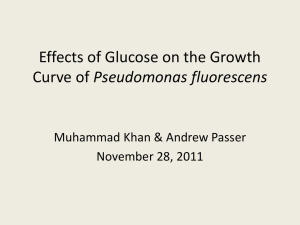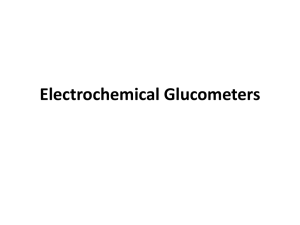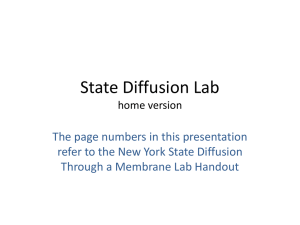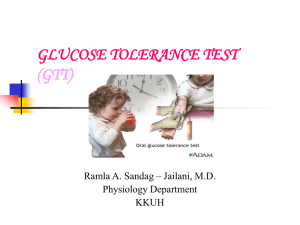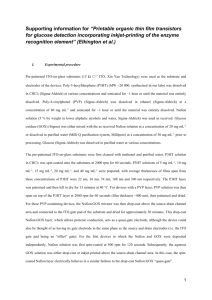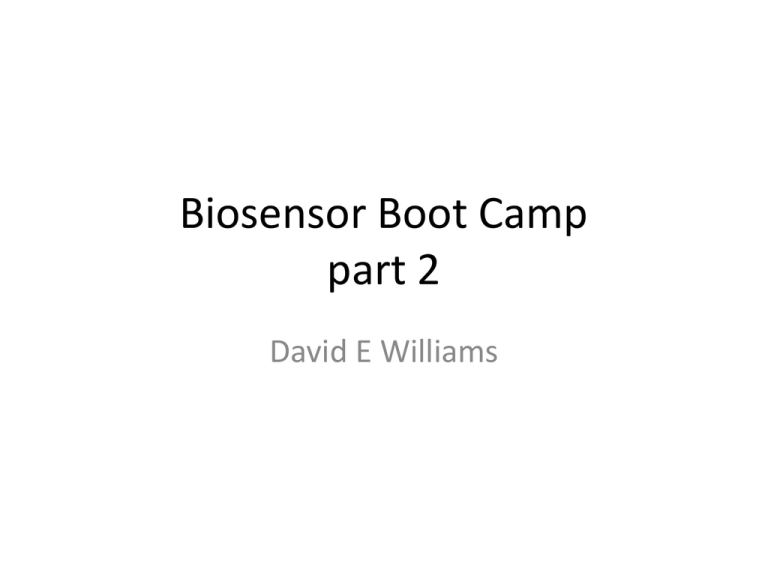
Biosensor Boot Camp
part 2
David E Williams
Title: ELECTRODE SYSTEMS FOR CONTINUOUS
MONITORING IN CARDIOVASCULAR SURGERY
Author(s): CLARK, LC; LYONS, C
Source: ANNALS OF THE NEW YORK ACADEMY OF
SCIENCES Volume: 102 Issue: 1 Pages: 29-&
DOI: 10.1111/j.1749-6632.1962.tb13623.x
Published: 1962
Times Cited: 1,093 (from Web of Science
Glucose
oxidasecontaining
membrane
Goxcontaining
membrane
Ag anode
Pt cathode
glucose
oxygen
Signal decreases as glucose increases in this configuration
In 1970, Dr. Clark demonstrated the enzymeactivated polarographic measurement of
glucose in water and pointed out that glucose
could be measured in whole blood with the
presence of the glucose oxidase enzyme.
Within a couple of years, YSI was able to
market its pioneering Model 23 Glucose
This model was the first whole-blood glucose
Analyzer with a polarographic electrode.
analyzer. The instrument directly measures the
whole-blood glucose level from a 25-microliter
sample within a ±2% accuracy. The sensor
created for the Model 23A was the first
commercial biosensor and was used in the
Miles Biostator, the first artificial pancreas. The
U.S. Food and Drug Administration has
identified the YSI Model 23A and subsequent
designs as the reference standard for
measuring glucose.
http://www.ysi.com/history.php
http://www.chemheritage.org/discover/collections/collec
tion-items/scientific-instruments/ysi-blood-glucoseanalyzer-model-23a.aspx
Ag/AgCl cathode
Pt anode: H2O2 oxidation
Hydrogen peroxide readily depolarizes the polarographic
anode and current flow, at a given applied voltage
(usually about 0.9 volt), is proportional to the hydrogen
peroxide concentration. If glucose were to be measured
in blood by mixing the enzyme and the blood, no glucose
would be detected because blood contains the enzyme,
catalase, which destroys hydrogen peroxide at a very fast
rate. This difficulty, and others, are circumvented through
the use of a cellulose or other membrane which is
permeable to small molecules, such as glucose, but is
impermeable to proteins. The membrane serves to keep
the glucose oxidase on the side of the membrane with
the anode and at the same time to keep other enzymes,
some of which, such as catalase, would ruin the reaction,
on the other side of the membrane. Glucose has a
molecular weight of 180 and can freely diffuse through
the membrane. The product of the reaction, hydrogen
peroxide, has a low molecular weight, only 34, but by
virtue of the design of the present invention is formed
directly on the platinum electrode surface where it is
detected, and in the process of being detected is, in part
at least converted to H20 and oxygen.
In 1970, Dr. Clark demonstrated the enzymeactivated polarographic measurement of
glucose in water and pointed out that glucose
could be measured in whole blood with the
presence of the glucose oxidase enzyme.
Within a couple of years, YSI was able to
market its pioneering Model 23 Glucose
Analyzer with a polarographic electrode.
http://www.chemheritage.
org/discover/collections/co
llection-items/scientificinstruments/ysi-bloodglucose-analyzer-model23a.aspx
This model was the first whole-blood glucose
analyzer. The instrument directly measures the
whole-blood glucose level from a 25-microliter
sample within a ±2% accuracy. The sensor
created for the Model 23A was the first
commercial biosensor and was used in the
Miles Biostator, the first artificial pancreas. The
U.S. Food and Drug Administration has
identified the YSI Model 23A and subsequent
designs as the reference standard for
measuring glucose.
http://www.ysi.com/history.php
Think a bit… the assumptions connecting
the measurement to the desired quantity
In the space: Glucose + O2 -> H2O2
At the electrode: H2O2 -> O2
concentration
Glucose conc
Current ~ gradient of
H2O2 at electrode
H2O2 conc
Oxygen conc
Small gap underneath
membrane relative to
membrane thickness
Gap is controlled – another
membrane
Large excess of Gox – fast
reaction
position
Home use glucose
Development of the home-use glucose sensor
Ferrocene-Mediated Enzyme Electrode for Amperometric Determination of Glucose
Anthony E. G. Cass,’ Graham Davis, Graeme D. Francis, and H. Allen 0. Hill*
Inorganic Chemistry Laboratory, University of Oxford, Oxford OX1 3QR, United Kingdom
William J. Aston, I. John Higgins, Elliot V. Plotkin, Lesley D. L. Scott, and Anthony P. F. Turner
Biotechnology Centre, Cranfield Institute of Technology, Bedford MK43 OAL, United Kingdom
Anal. Chem., 1984, 56 (4), pp 667–671
Removes oxygen
dependence
Eliminates uric acid and
ascorbate interference
Concept for a single use,
batch calibrated device
Fc + glucose + GOx
Fc
or Fc + glucose
or Fc + GOx
glucose + M(ox)
Fc+
GOx
gluconolactone +
M(red)
Fc
the reaction : Fc+ + glucose + GOx
regenerates Fc near the electrode so
current doesn’t decrease
Fc → Fc+ + eanodic current decreases
when Fc is depleted near the
electrode
for glucose measurement, hold potential constant at ~ 0.4 V and
measure current
The reaction of Fc+ and GOx(red): a classic ErCi’ system
E = electrochemical step
C’ = homogeneous catalytic chemical reaction
r = reversible
i = irreversible
Examples of some other classic mechanisms:
ErCr
ErCiEr
CrEi
(C = homogeneous chemical reaction)
bulk concentrations, i.e.
what’s added at the start
Fc/GOx system
R (Fc)
O (Fc+) + e
k’
O (Fc+) + Z (glucose) R + Y (gluconolactone)
A.J. Bard, L.R. Faulkner, Electrochemical Methods: Fundamentals and Applications, ed. John Wiley:
New York, 2001; Chapter 12.
Reaction consumes ‘O’ and regenerates ‘R’ in the boundary layer near the
electrode as ‘O’ is produced at the electrode
R (Fc)
O (Fc+) + e
k’
O (Fc+) + Z (glucose) R + Y (gluconolactone)
Technology and market drivers
• Lower blood volume
• More precision
• Avoiding other peoples’ patents
• -> coulometers
• -> high concentration solutions of enzyme and
mediator
• -> old (ferrocyanide) and new (osmium)
mediators
Chamber of precisely
known volume, capillary
fill
Dried reagents give high
concentration solutions
Complete conversion of
glucose in sample to
gluconolactone with
equivalent reduction of
ferricyanide
Coulometric
determination of amount
of ferrocyanide produced
Precision determined by
precision of manufacture
of the defined sample
volume
Lifescan ‘one-touch’
reagents
spacer
100um
gap
Electrodes in
chamber
~1uL sample volume; 5s measurement; made by web printing process : 106 / hr
http://ubimon.doc.ic.ac.uk/bsn/public/bsn-2005-Heller.pdf
Therasense :
Adam Heller
Glucose gluconolactone
GoX
Os(III)
Os(II)
http://ubimon.doc.ic.ac.uk/bsn/public/bsn-2005-Heller.pdf
http://www.boots.com/en/Pharmacy-Health/Health-shop/Diagnostics-electricalhealth/Blood-glucose-monitors/
Random Thoughts list
• Strep – antigen extraction
• Glucose – how devices changed and the
assumptions behind operation
• Flow injection, protective membranes,
Bourtelle and Albery, one shot
• Microfluidics
• Surfaces and interactions
• Immunoassay theory
number of systems in range
12
10
8
6
4
2
0
0
20
40
60
percentage of readings ±5 mg/dL
80
Freckmann et al. “System Accuracy Evaluation of 27 Blood Glucose Monitoring
Systems According to DIN EN ISO 15197”. Diabetes Technol. Ther. 2010, 12. 221231, DOI: 10.1089/dia.2009.0128




